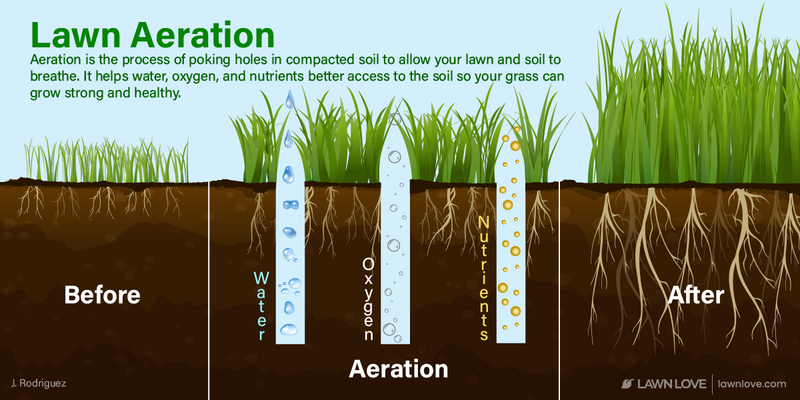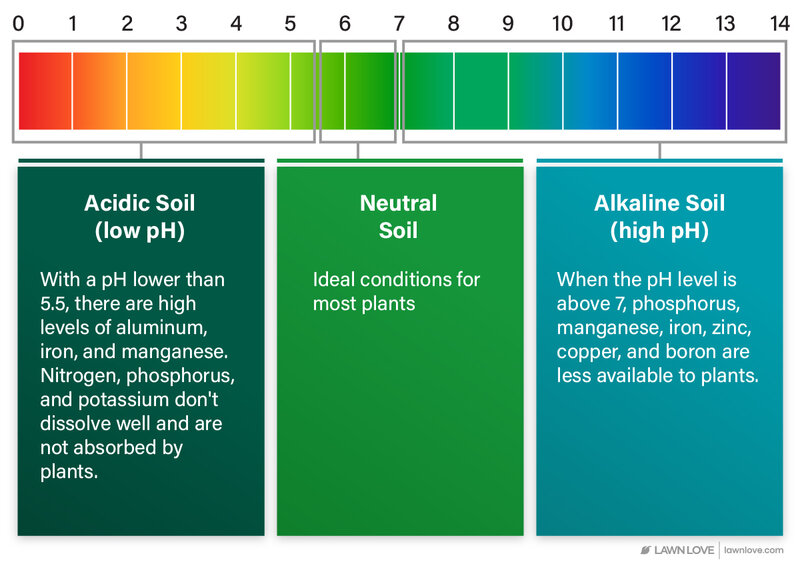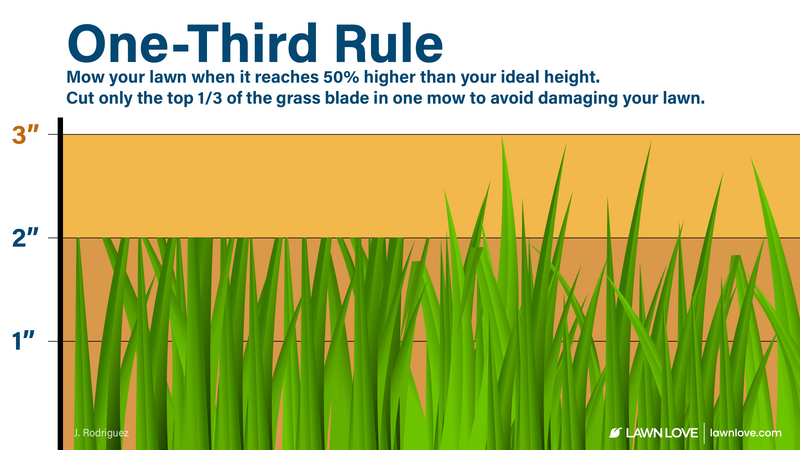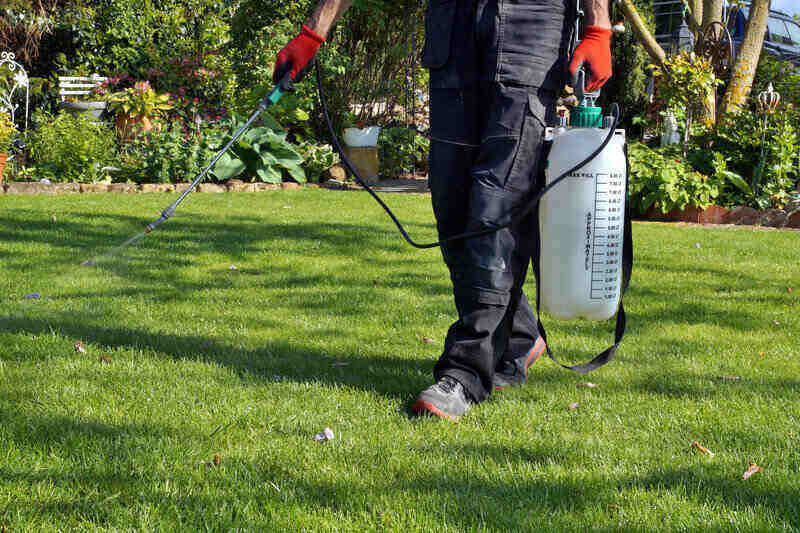
Fall certainly flies into the birthplace of aviation. One minute it’s summer pool weather, and the next leaves are turning from emerald green to amber and ruby in the Gem City.
Autumn in Dayton is a sight to behold, but lawn care can get complicated as cold weather approaches. Our fall lawn care checklist will prepare your lawn for winter so it’s ready to grow strong in spring.
- 1. Rake regularly
- 2. Keep watering until the ground freezes
- 3. Dethatch, if needed
- 4. Aerate compacted soil
- 5. Overseed before the first frost
- 6. Test your soil, if needed
- 7. Fertilize for vigorous growth
- 8. Control weeds with herbicide
- 9. Plan your final mow of the season
- 10. Winterize your irrigation system
- 11. Put gardens to bed
- Call in a pro
1. Rake regularly
Raking just once won’t cut it in Dayton! With all our deciduous tree leaves, you’ll need to rake leaves every three to four days to keep your lawn healthy.
When dead leaves build up on your lawn, they block sunlight, water, and air from reaching your grass. This can cause:
- Disease and fungal growth
- Soil compaction
- Pest infestations
- Dead grass
Raking regularly keeps your soil oxygen-rich and your grass healthy for next year.
Don’t throw away your leaves! Either compost your leaves to give your grass a healthy layer of organic matter in spring, or mow them and leave them on your grass to decompose. They’ll act as a natural mulch and give your soil a nutrient boost.
2. Keep watering until the ground freezes
The weather may be cooler, but your grass still needs to hydrate. A big secret to lawn success in Dayton? Since we grow cool-season grasses here, fall and spring (not summer!) are the most productive growing seasons. Give your grass 1 to 1½ inches of water per week for fall success.
Stop watering after the first freeze, which normally occurs between mid-October and mid-November in Dayton.
Irrigation tips:
- Water in the morning before 10 a.m. to minimize evaporation from the midday sun. Don’t water at night, as this can invite pests and cause disease.
- Water your lawn deeply and infrequently (once or twice a week) to encourage a deep, dense root system. Shallow, frequent waterings keep grass roots near the soil surface, which makes your grass weaker and less drought-resistant.
- Don’t water when daytime temperatures drop below 40 degrees Fahrenheit. This can cause a sheet of ice to form overnight, which results in grass getting matted or suffocating.
3. Dethatch, if needed

If your lawn has a thick layer of spongy brown matter between the grass and the soil, your lawn needs to be dethatched.
Dethatching is like a dandruff treatment for your lawn. It’s the process of vigorously raking up excess thatch (the layer of dead grass, leaves, and other organic matter between grass blades and the soil surface) to give grass roots access to water, oxygen, sunlight, and nutrients.
The problem with excess thatch: While a thin layer of thatch is a healthy insulator for your soil, a layer over half an inch thick acts as a barrier against sunlight, water, and nutrients. It diminishes soil quality and stifles root growth.
How to remove thatch: Deeply rake your lawn using a manual dethatcher, electric dethatcher, power rake, or verticutter. If you’re dethatching a small area with a mild thatch problem, use a manual dethatcher. If you have a large lawn with a serious thatch problem, a power rake or verticutter is the way to go.
Why dethatch in fall: Dethatching is an intense lawn process that can stress your grass. When you dethatch in early fall, your cool-season grass is actively growing and can recover quickly before winter.
How often should I dethatch? Dethatching is only necessary when thatch is over half an inch thick. If you keep your lawn healthy with regular mowings, waterings, and fertilizer applications, you should only have to dethatch every few years.
4. Aerate compacted soil

If dethatching is like a dandruff treatment for your lawn, then aeration is like a facial that opens up your soil’s pores. Aeration is the process of poking holes in your soil to alleviate compaction and increase the flow of nutrients.
Aeration:
- Gives grass roots space to spread
- Encourages dense, green grass growth
- Reduces harmful runoff
- Increases your grass’s resistance to disease
- Makes your grass more drought tolerance
- Cuts down on fertilizer needs
- Increases the population of beneficial soil organisms (like earthworms)
Unlike dethatching, aeration isn’t just a fix to a problem. It’s a healthy, preventative lawn care practice. For Dayton’s Miamian soil, it’s a good idea to aerate every year or every other year.
When to aerate: Like dethatching, aeration is temporarily stressful for your grass. Aerating in fall gives your grass time to recover and minimizes weed growth. (Weeds love to grow into the holes if you aerate in spring.)
If your lawn has both a thatch and a compaction problem, you’ll need to dethatch and aerate. When you’re doing both, always dethatch before you aerate. It’s much easier to aerate your soil once the thatch is gone.
Pro Tip: To promote grass recovery, fertilize your lawn one week prior to aeration. It’s a great idea to overseed your lawn after aeration while the soil is open.
5. Overseed before the first frost
Remember that fall is an important growth period for cool-season grass? That comes in handy when you need to patch up your yard from a summer of kickball and barbeques! In Dayton, you can grow fresh grass in fall to fill in bare patches for a dense, even spring lawn.
What is overseeding? Overseeding is the process of spreading more seeds over your existing lawn to fill in spotty areas with new growth.
When to overseed: Spread seeds in early fall (at least 45 days before the first frost of the year) to give grass time to establish and grow deep roots before going dormant. Dayton’s first frost usually occurs in late October, so overseed in early to mid-September.
What grass should I use to overseed? For Dayton’s midwestern climate, it’s best to overseed with tall or fine fescue, Kentucky bluegrass, or ryegrass, or a mixture of these varieties.
6. Test your soil, if needed

Soil quality and nutrient levels change over time, and it’s important to know what soil amendments your lawn needs for healthy grass growth.
For example, Ohio soil is often clay-heavy and acidic, so many homeowners need to amend their soil with compost and lime or wood ash (but you’ll need a soil test to know exactly what your lawn specifically needs).
A soil test will tell you:
- Your soil’s nutrient levels and deficiencies
- Salt levels (salinity)
- pH imbalances (acidic, alkaline, or basic)
- Soil factors that might be suppressing plant growth
- The ideal fertilizers and soil amendments you can add to balance your soil and increase nutrient levels for healthy grass growth
Test your soil every three to five years. Check out the Ohio State University Extension’s list of soil labs where you can send your samples for testing.
7. Fertilize for vigorous growth

Fall is the ideal time to apply a nitrogen-rich fertilizer to your cool-season lawn.
According to Purdue University, applying fertilizer:
- Helps grass recover from damage and stress
- Keeps grass growing densely (unfertilized grass gradually loses its density)
- Prevents weed encroachment
- Protects grass’s rich green color
- Improves grass’s tolerance to heat, drought, and cold weather
- Increases disease and pest resistance
- Prepares turf for winter
- Does all this without an unsustainable growth surge
What is N-P-K? N-P-K refers to the fertilizer’s ratio of nitrogen, phosphorus, and potassium (the three most essential soil nutrients). For example, a fertilizer with a ratio of 26-0-12 contains 26% nitrogen, 0% phosphorus, and 12% potassium.
What’s the best N-P-K ratio for my lawn? Your soil test will tell you the ratio of nutrients your lawn needs, so you can choose a fertilizer that addresses your lawn’s nutrient deficiencies.
Consult your soil report to see how much fertilizer is recommended for your lawn. It’s a good idea to fertilize your lawn on a regular schedule, two to four times per year: In early spring, mid-spring, early autumn, and late autumn.
If you’re not satisfied with your grass’s growth, you may want to opt for four applications of fertilizer per year. However, note that the more nitrogen you apply to your lawn, the more frequently you’ll need to mow.
8. Control weeds with herbicide
Pre-emergent herbicide
Want to prevent weeds from rearing their heads in spring? Apply a pre-emergent herbicide in fall to stop weed seeds from germinating during the winter months. Pre-emergent herbicide creates a chemical barrier on the soil’s surface that prevents weeds from seeing the light of day.
Pre-emergent herbicides are excellent at preventing these common Dayton weeds:
- Smooth and large crabgrass
- Yellow foxtail
- Annual bluegrass
When to apply pre-emergent herbicide: Early October to late November.
Post-emergent herbicide
While pre-emergent herbicide stops weeds before they start growing, post-emergent herbicide kills existing weeds. If you have persistent perennial weeds, fall is the perfect time to spray them with a post-emergent herbicide.
Why spread post-emergent herbicide in fall: As winter approaches, perennial weeds transport carbohydrates from their foliage to their roots to store food. When you apply post-emergent herbicide, the weed absorbs it and transports it with the carbohydrates all the way to the roots. This destroys the plant.
Post-emergent herbicides will kill tough perennial weeds like:
- Thistle
- Buckhorn plantain
- Nutsedge
- Ground ivy
When to apply post-emergent herbicide: Mid-September to early November, while temperatures are still above 50 degrees Fahrenheit. You want to apply post-emergent herbicide while weeds are actively growing.
Pro Tip: Overseeding and herbicides don’t mix, as herbicides will kill tender grass sprouts. If you’re applying herbicide, you’ll need to postpone overseeding until spring. Choose which step is most necessary for your lawn this fall.
9. Plan your final mow of the season
Keep on mowing until your grass stops growing! When you notice that your grass isn’t getting longer (usually when daytime temperatures fall below 50 degrees Fahrenheit), it’s time to get the mower out one last time.
How long should I mow my grass? Cut your grass to either the same length or slightly shorter than usual. The Ohio State University Extension recommends that you mow your cool-season turfgrass to a height of 2 inches, rather than the normal 2.5 to 3.5 inches, to prevent snow mold and matting.
Just make sure not to scalp your grass by mowing too low. You don’t want to damage your grass right before a tough winter!
Follow the one-third rule. Never mow more than one-third of your grass’s length. For example, if your grass is 3 inches high, cut no more than 1 inch off the top. Cutting more than one-third of your grass can stress it and make it more susceptible to pests and disease.

10. Winterize your irrigation system
The last thing you want is to turn on your sprinklers in spring and have water gush everywhere! Winterizing your sprinklers prevents cracked pipes, broken valves, and nonfunctional sprinklers, so you won’t have a massive repair bill in spring.
Winterizing your sprinklers involves turning off the water supply and then draining (“blowing out”) all water from the system and equipment. This process should be performed in early to mid-October before Dayton’s first hard freeze in late October.
Pro Tip: Always wear proper eye protection when winterizing your irrigation system.
11. Put gardens to bed

It’s time to tell your flowers and veggies a story and tuck them into bed (well, the storytelling is optional). Winterizing your garden prepares your plants for a cold winter and protects them from disease, weeds, and pests.
How to winterize your garden:
- Clean out dead annuals and weeds to prevent disease and pest infestations.
- Divide overgrown perennials so they don’t compete for space and nutrients come spring.
- Add soil amendments (like rich compost) that will decompose over winter. In spring, nutrient-rich soil will encourage plant growth.
- Trim shrubs and perennial plants.
- Prevent snow damage by tying arborvitae, shrubs, and other perennials with jute or twine.
- Insulate the soil bed with a 1- to 4-inch layer of mulch. This will regulate soil temperatures and stop plants from growing too soon if there are a few warm days in winter.
- Water plants a final time before daily temperatures dip below 40 degrees Fahrenheit.
Call in a pro
With plenty of fall color, Dayton lawns are nothing if not dynamic, but that also means they require some extra TLC. Start thinking about your fall checklist in early September to get your lawn prepared in time for winter, so you aren’t stuck maniacally spreading seed, raking, and singing your veggies a lullaby at once.
If you don’t know the front end from the back of an aerator, or if you’d rather spend some quality time with friends and family at a Flyers game, you can call a local team of lawn care pros to do the mowing, raking, and winterizing for you. Kick up your feet, enjoy a delicious buckeye (or nine), and let a pro handle all your fall lawn care.
Main Photo Credit: StockSnap | Pixabay

